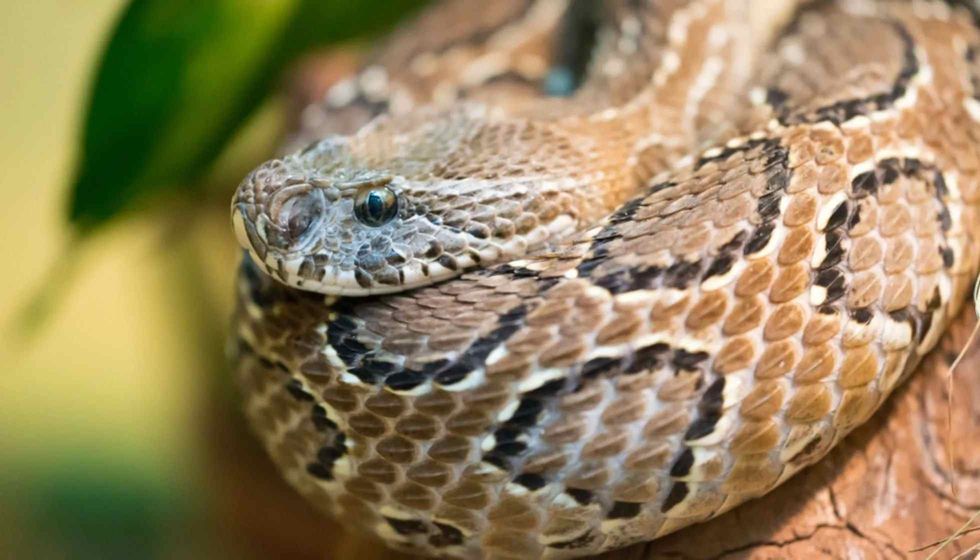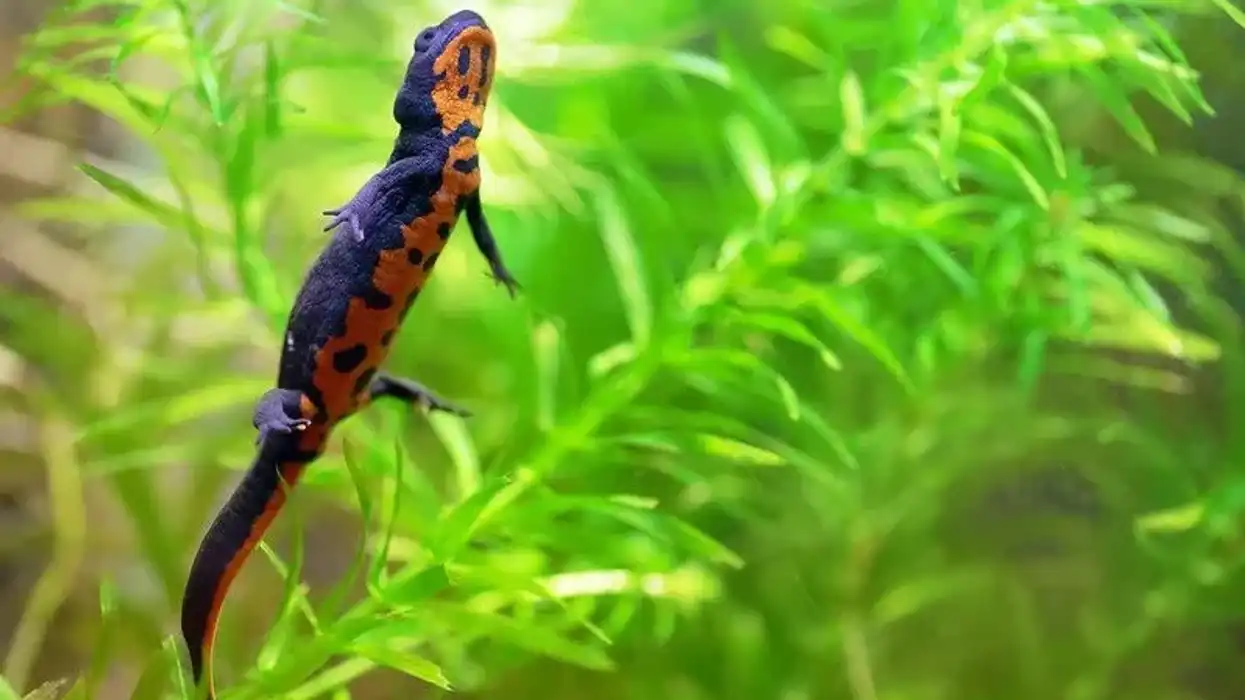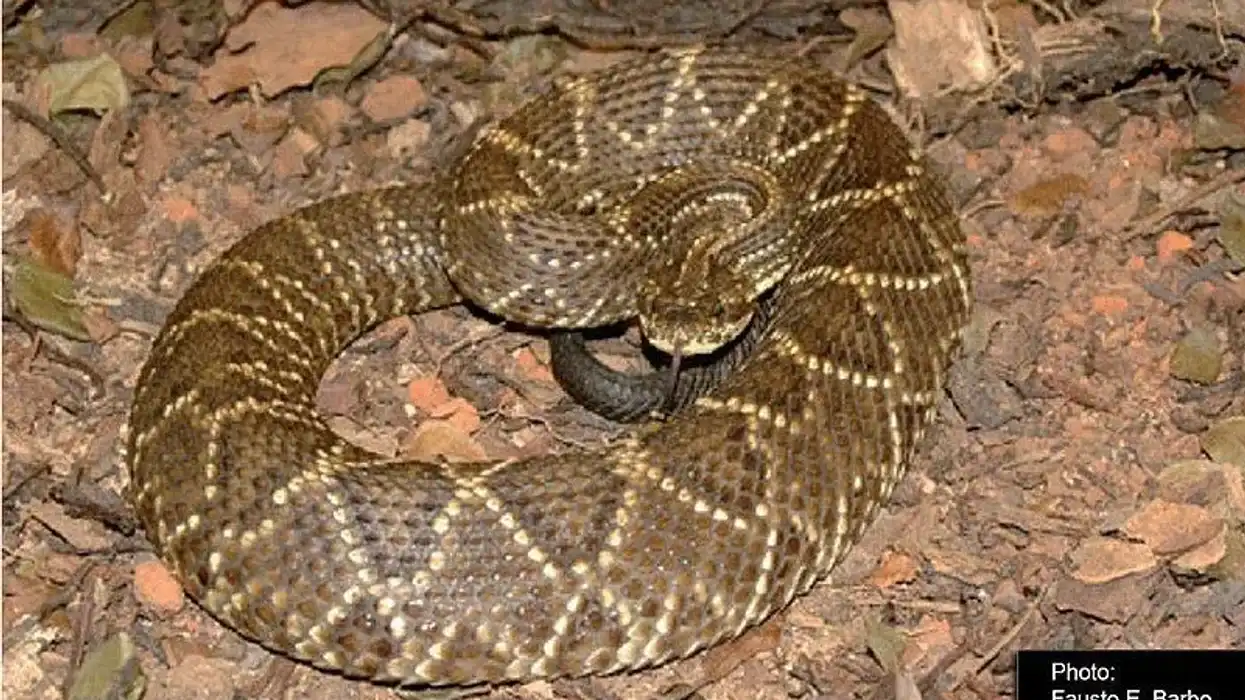The Russell's viper (Daboia russelii) is a species of viper snake native to the Indian subcontinent. It is one of the 'Big Four' of venomous snakes in India, which includes the Common Krait, Russell's viper, Indian saw-scaled viper, Indian cobra.
Its real name is Daboia, which has been adopted as a genus name for three other species of vipers, namely the Moorish viper, the Palestine viper, and the eastern Russell viper. Its real, Hindi name translates to 'the one who lurks'.
It was named Russell's viper for Patrick Russell, a Scottish naturalist. It has many other regional names in India, and it is also found in the countries of Sri Lanka, Nepal, Bangladesh, Myanmar, Pakistan, Thailand, Tibet, Cambodia, China, Indonesia, and Taiwan.
The Indian Russell's viper is particularly deadly, being responsible for half the snakebite-related deaths in India. This is because it is attracted to human settlements because of its preferred diet of rodents.
It is aggressive and one of the most venomous snakes in India. It is found in open grassy habitats and also plains and farmlands.
For more relatable content, check out these rough green snake facts and worm snake facts for kids.
Russell's Viper Interesting Facts
What type of animal is Russell's viper?
The Russell's viper (Daboia russelii) is a snake.
What class of animal does Russell's viper belong to?
Russell's viper (Daboia russelii) belongs to the reptile (Reptilia) class of animals.
How many Russell's vipers are there in the world?
It is unclear how many Russell's viper snakes are there in the world, but they exist in abundant numbers in the Indian subcontinent.
Where does Russell's viper live?
Russell's vipers is found in open grassy places, scrublands, bushy areas, coastal lowlands, plains, urban settlements
What is Russell's viper's habitat?
Russell's viper snakes are nocturnal feeders who like to live alone. The Russell's vipers do not favor dense forests or vegetation. They may hide in caves, under leaves, or in the soil cracks.
These snakes are found in farms and plantations and along the hills. Russell's viper snakes are unlikely to exist above 9,800 ft (3000 m). Because of rodents like squirrel being its preferred food, Russell's viper is often attracted to urban settlements.
Who does Russell's viper live with?
Russell's vipers usually live alone.
How long does Russell's viper live?
A Russell's viper lives for about 15 years on average.
How do they reproduce?
Russell's vipers reproduce by mating give birth to young vipers. The mating usually takes place early in the year and the female's pregnancy lasts up for about six months, after which it gives birth to a litter of 20-40 snakelets, usually in the months between May to November.
What is their conservation status?
The Conservation Status of Russell's vipers has not been evaluated.
Russell's Viper Fun Facts
What do Russell's vipers look like?
Russell's vipers are usually 1.2-1.9 m (4-6 ft) long and weigh 15-22 lb (7-10 kg). The overall color of their bodies is either brown, tan, or deep yellow. They also have very prominent brown spots that are dark brown and have a black outer ring.
A yellow or white rim surrounds this outer ring. The heads have dark patches on either temple with brown or pinkish X or V marks. They have heads that are flat and triangular.
The snout is round and blunt. They have large nostrils and eyes.
The eyes have gold and yellow around them. They may have 2-5 pairs of fangs, which may be as big as 0.65 in (16.5 mm). The tails of Russell's Vipers are only 14% of the body length.

How cute are they?
Russell's vipers, being deadly snakes, can hardly be described as cute. These snakes do, however, have a majestic appearance and are known to form 'S' shapes while moving around.
It is quite a thing to see these snakes become aggressive, coiling into circles and raising a third of its body, and striking at great speeds. Russell's viper snakes are beautiful creatures, but there is nothing cute about them.
How do they communicate?
Russell's vipers communicate through smells, pheromones, gestures like twitching and jerking. Also, when threatened, Russell's vipers hiss loudly.
How big is Russell's viper?
Russell's vipers grow to be around 4-6 ft (1.2-1.9 m) long, which makes it 11 times bigger than the Barbados threadsnake.
How fast can Russell's viper move?
Russell's vipers move sluggishly during the day, but during the night or when they're threatened, they may move at 2 mph (3.3 kph).
How much does Russell's viper weigh?
A Russell's viper weighs around 15-22 lb (7-10 kg).
What are their male and female names of the species?
The males and females of the Russell's vipers species do not have specific names.
What would you call a baby Russell's viper?
A baby Russell's viper may be called snakelets or neonates.
What do they eat?
Russell's vipers may eat a variety of other animals such as rodents, small reptiles, scorpions, land crabs, arthropods, and lizards.
Are they poisonous?
Yes, Russell's vipers are very poisonous. They are responsible for the most amount of deaths by snakebite in the Indian subcontinent.
Would they make a good pet?
No, Russell's viper would not make good pets. They are responsible for thousands of deaths in their habitat range and a generally dangerous snake.
Did you know...
The Eastern Russell's viper is known by the name Daboia siamensis.
Russel's vipers love to eat small reptiles. The juveniles of this snake species are known to become cannibalistic.
The Asian Russell's viper snake is effective at causing thrombosis i.e. blood clotting. Its venom is fast-acting and causes lots of discomforts. The Russell's viper snake's venom, however, can be countered with an antivenom. The antivenom needs to be administered quickly to counter the snake venom.
A clinical trial for an antivenom was conducted in 2016 in Sri Lanka.
The hypopituitarism caused by the bite of the Russell's viper sometimes resembles Sheehan's syndrome found in infants.
The Indian Russell's viper snake is often found in rice fields, before and after harvest. People working on farms in India, particularly Punjab in Northern India, often deal with the snake venoms of Russell's vipers. The snake is often found in the hilly Western coast of India, as well as the Southern state of Karnataka.
Although the Russell's vipers mating season happens early in the year, it is not uncommon for it to go on up till May. The young are usually born any time from May to November.
The name of the Russell's viper comes from Patrick Russell, a Scottish naturalist, and herpetologist; Patrick Russell studied Indian snakes in the late 18th century. Patrick Russell worked for the East India Company, and studied the various venomous snakes of India.
How dangerous is Russell's viper?
The Russell's viper is one of the most dangerous species of snake in the world, and especially in the Indian subcontinent, to which it is native. It is estimated that around half the snakebite deaths in India are caused by Russell's Vipers.
They get hostile very easily, move very quickly when they intend to bite and deliver the maximum possible dose of venom when they do bite. Their venom may cause kidney failure and hypopituitarism, and mostly death.
What happens if Russell viper bites?
After being bitten by Russell's viper, the venom causes pain and swelling at the site. There is internal bleeding, seen in urine, gums, and sputum. The heartbeat rate and the blood pressure decline.
Blistering and superficial necrosis is observed at the site. There may be vomiting, facial swelling, kidney failure, and blood clots that may form inside the body.
A person may experience a lot of pain for several weeks. Death may eventually be caused by the venom within 14 days due to failure of the kidneys, respiratory system, or cardiac system. Septicemia may also be the cause of death.
Here at Kidadl, we have carefully created lots of interesting family-friendly animal facts for everyone to discover! For more relatable content, check out these boa facts and smooth green snake facts pages.
You can even occupy yourself at home by coloring in one of our free printable Russell's viper coloring pages.









